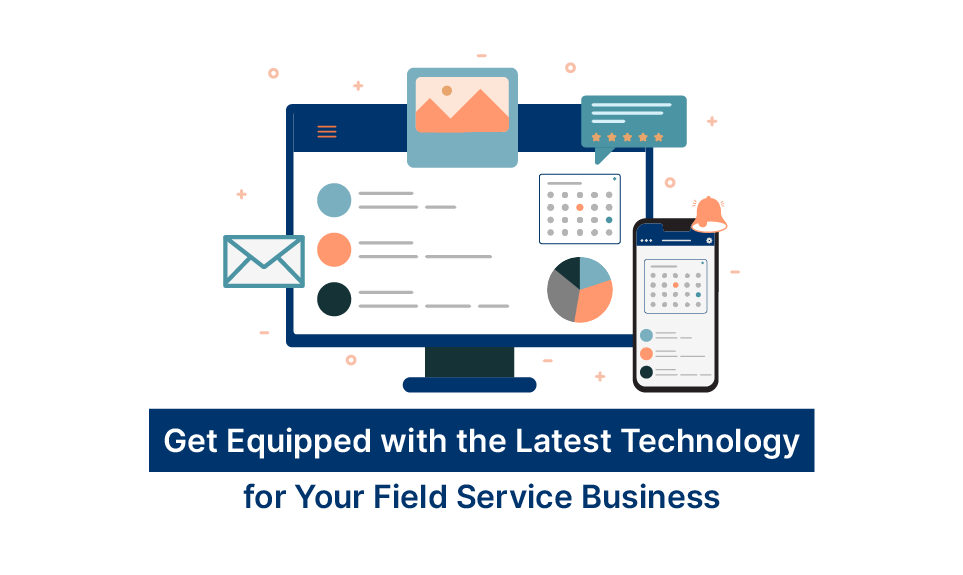The COVID-19 pandemic left quite an impact on the field service management (FSM) industry.
FSM businesses need to switch to field service management software to keep up with evolving customer expectations around the Uberization of field service. In 2019, the field service management software industry was at $2.85 billion, and it is expected to rise to $7.10 billion by 2026 with a CAGR of 15.4 percent.
However, not all field service management software is created equal. This is for you if you are looking to get equipped with the latest FSM software but have no clue where to start. This blog discusses why you need to invest in FSM software and the features you need to keep an eye on. Without further ado, let’s begin!
Reasons why you need to invest in field service technologies
Outdated FSM tools like spreadsheets and online forms lead to inefficient operations. Everything from tracking a work order to knowing the field service technician’s exact location is a hassle. FSM processes don’t just require a lot of manual intervention, they are also subject to errors and inaccuracies. These inefficiencies affect both internal stakeholders and customers alike.
Switching your business with field service management technologies can eliminate your operational inefficiencies once and for all. Here are some compelling reasons to invest in field service management software.
Accurate scheduling and dispatching
Manual scheduling and dispatching increase the possibility of double booking, overlapping schedules, and failed customer visits. Paper-based schedules consume a lot of space and are prone to be misplaced or lost. Just dispatching a single technician can take hours; as dispatchers spend time searching through cluttered spreadsheets searching for an open time slot.
When you begin using Zuper’s field service management software you will no longer be burdened with scheduling troubles. Zuper’s assisted scheduling feature will assess your technician’s schedules and suggest the right person for the job. For instance, if a technician has a conflicting appointment or is on time off, the dispatcher will receive conflict alerts.
Up-to-date inventory management
From depositories to the field, around 52 percent of the FSM businesses still follow manual tracking and update processes like:
- Spare parts brought in as new or unused ones
- Live location tracking of work order parts
- Update Purchase orders
- Equipment transfer between on-site and off-site
By automating these with FSM software, you can reduce the time spent in inventory. This kind of inventory management is an intelligent way of running a business.
Work order management
The problem of transcription errors increases dramatically with the more service calls a technician runs in a day. With each technician handling multiple calls, the opportunity to put incorrect information on the wrong piece of paper (wrong call) becomes increasingly likely. When you digitize the work order process these sorts of mistakes become a rarity.
Once your technicians begin using FSM software, completing work and job orders occur concurrently with no room for errors. The documentation process is made simpler by doing live documentation, image/video capture, and parts can be ordered if needed. They connect the field and the back office professionals, smoothing communications and helping to create a better customer service experience.
Improved customer experience
Nowadays, customers are looking for visibility in maintaining a timely schedule. They do not like to be left in the dark regarding field services. By keeping them in the loop about the status of the technicians, like—time of service, en route notification on technician’s location, and automated alerts on appointment booking.
There is an undeniable relationship between quality customer service and on-time service delivery.
Productive employees (on-field and back-office)
Tracking an employee’s whereabouts is now possible. You heard it right. Now you can follow the live location of your field technicians from the back office without needing to make multiple phone calls to see if they have reached your next client.
Now, it doesn’t end with just tracking them. You can smart schedule the work based on priority and location requirements and optimize the employee’s route.
- Live tracking – You can live track employees’ location from the back office. An installed mobile application will follow their location in real-time. Live.
- Route optimization – You can optimize the route of your employees based on the employee requirement—no excuses for being late for work or delay reaching the following client location.
- Geo-tagging – Tagging the customer’s exact location to the software makes the job easier for the follow-up technician to not inquire about the address again.
- Geofencing – Marking the location to a certain radius within the customer’s vicinity. Let’s say a customer’s site is geo-fenced to a radius of 3 km; once the technician enters that radius, they can mark it as ‘on my way, ‘making it easier for the back office to update the customer location of the technician.
Contract and asset management
Managing a contract with your customer as a POC (Point of Contact) for the next 10-15 years for their HVAC, pool, solar, etc. Maintaining a manual booklet would only double your workload.
Once you invest in a field service management tool; your workload drastically reduces. All you need to do is gather all the information from the customer, build the contract, and record it in your system—no more going through the paperwork again. You will be informed automatically when the product changes, providing the service or contract renewal.
Field service software trend features you should keep an eye on
The field service management industry is awash with new technologies; there is no excuse for not being aware of the recent technological updates. We are going to save you some time, and talk about some of the more significant innovations; if you still want to do your own research later, the Internet is there.
AI automated chatbots
Making multiple calls to get assistance from the back office team and checking on job creation and stock availability every time you are at a client’s place is an exhausting task. With AI automated chatbots, you need not stay on hold or stop your work to make a call. All you need to do is enter your question or search query in the chat box, and voila! You will get the results immediately, and you can also complete your work on time.
Mobile application
Mobile phones have become ubiquitous. Gone are the days when a technician would wait until the end of their day to complete paperwork, create a new work order, update their inventory, or put in an order for a new part.
Ever thought about opting for a mobile application? You can look up the Zuper mobile app; here, we provide a distributed service of:
- Login for all – Customer-friendly applications, providing access to one and all. With your customer’s Google or Facebook ID, you can encourage them to create a login for online appointment bookings.
- One for all – A single software that can be used on a web browser or mobile application, making the integration seamless and consistent.
- Information flow – You can update the information at any location. A versatile mobile application—creating a job, uploading images, editing, and holding marketing campaigns can all be made through a mobile app.
- Booking technicians – With your customers also having access to your mobile application, booking appointments becomes simple; customers can locate the nearest technician without having to call in or stay on hold.
- Pay online – Your technicians need not wait to receive payment from customers who are unavailable. They can complete the services and send an invoice electronically instructing them to pay online.
Cloud storage
Are you still spending a sturdy amount on buying all the file storage goodies for maintaining your client information? Register for cloud storage software to save all the client information like—the last service date, next service due, contract signed, an asset that you have changed, etc.
Assisted scheduling
Imagine taking a step back from a long day of work and letting software handle scheduling for you. We at Zuper have designed field service management software that resolves your scheduling issues:
- Multiple entries – The size of your company is not a limitation when it comes to automatic scheduling. You can create various work orders, assign multiple tasks, and generate countless invoices anytime the need arises.
- Scheduling – Scheduling and rescheduling your technicians without going through multiple emails or chasing paper trails.
- Territory planning – You can smart schedule your technicians based on their location, availability, priority, and skill set.
- Looping the customer in – Frequently checking the technician’s location is troublesome; field service management software will keep the back office team and stakeholders updated with the current site.
Remote timesheet management
Field service companies appreciate software that can keep track of an employee’s schedule, absenteeism, overtime worked, and calls closed. What details will your remote timesheet management software contain?
- Shift management – You can digitally manage your technician’s roster details and maintain a proper shift log and working hours.
- Leave – Your employees can apply for leave through the mobile app. The mobile app allows you to distinguish between sick leave, vacation, and bereavement leave.
Route optimization
You can optimize your employee’s locations and schedules to maintain a customer’s time slot. A technician working nearby can change jobs based on the geofencing functionality available with Zuper field service management software.
Internet of things (IoT)
The Internet of things has become a connecting bridge between the customers and service providers. Technology is in a complete transitional phase of making things online. This transition has enabled: customer convenience, increased productivity, proactive maintenance, and an increase in revenue.
Conclusion
As the adoption of digital technologies continues to grow, and broad access to that technology has become a reality, a bridge has been established between customers and technicians. People are looking to make the most of it with FSM software. Field Service companies have taken the next step and trusted AI to do the things people are bad at—filling out repetitive paperwork and optimizing their routes for the day—and letting people focus on what they are good at, delivering quality customer service to other people.
Nevertheless, certain FSM businesses are reluctant to take that next step. For those very few people, I would suggest you check out Zuper’s free trial option to get a different idea about the software.





